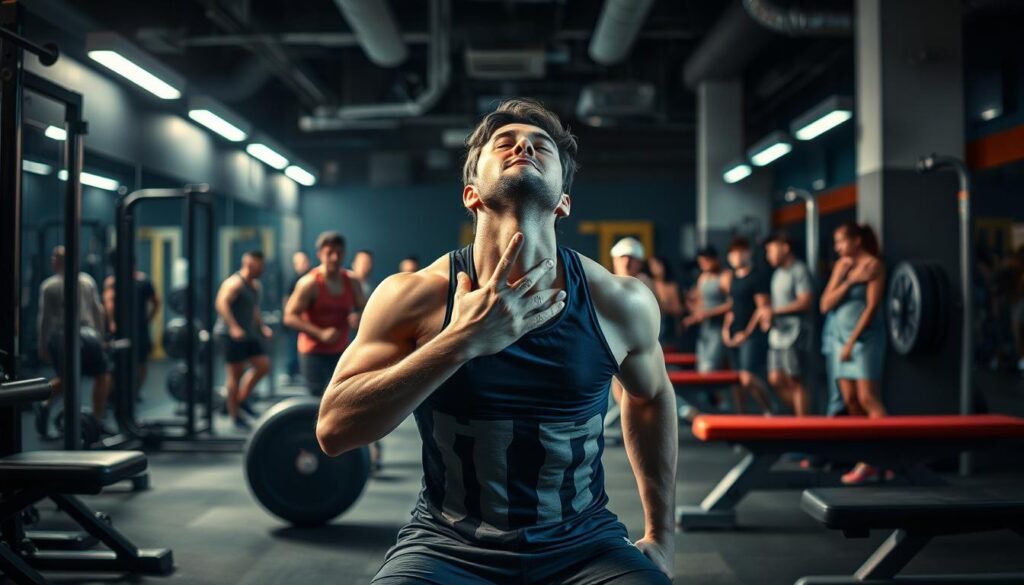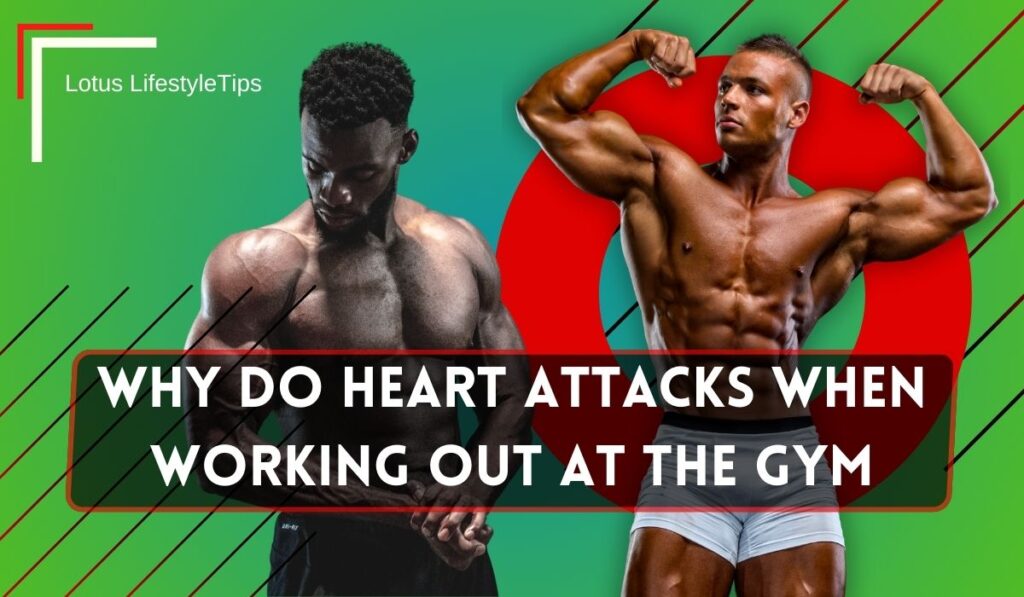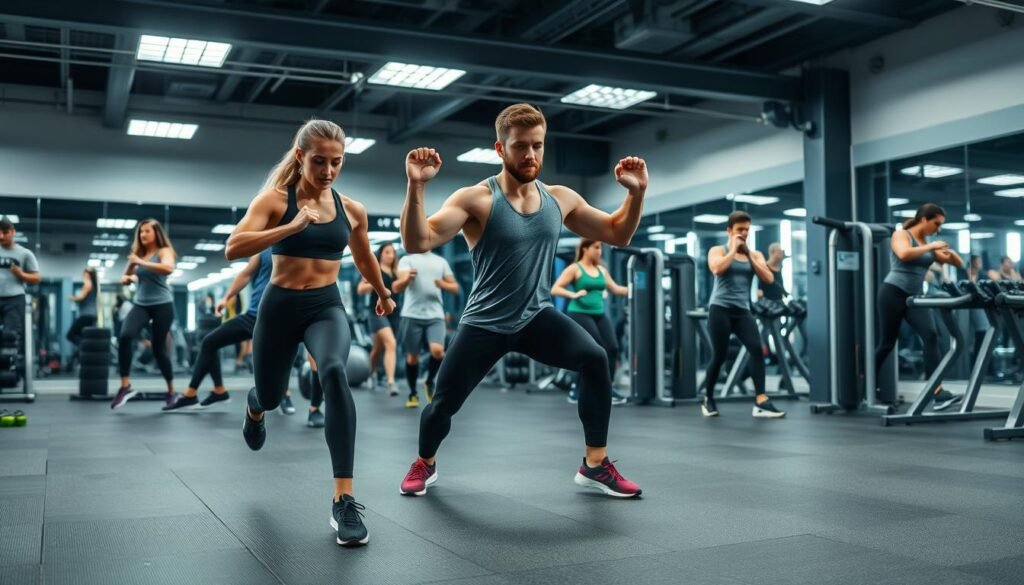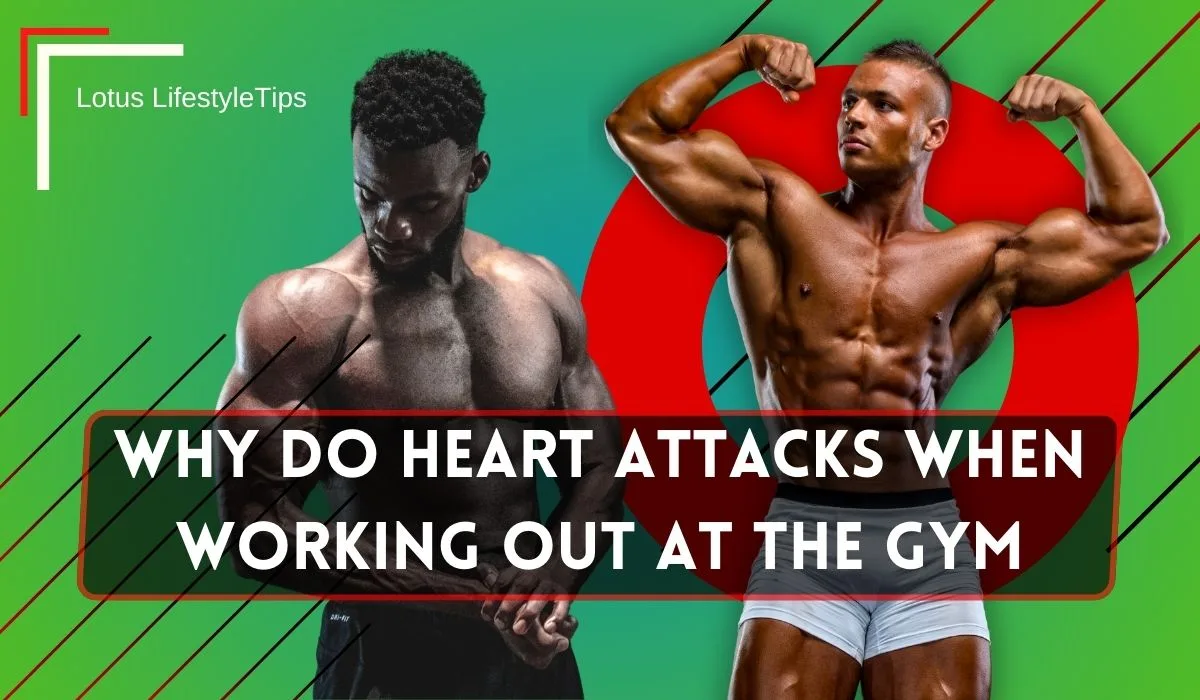Imagine the shock when a healthy person collapses from a heart attack at the gym. It makes us wonder about the link between Exercise and Heart Health. Experts are looking into why this happens and how to keep gyms safe. Heart Attacks When Working Out At The Gym.

Exercise is good for the heart, but it can be risky for some. Those with heart issues or unusual symptoms should see a heart specialist before intense workouts.
Exercise helps the heart, but only up to a point. Too much can change the heart’s structure. Finding the right balance in workouts is important.
Understanding gym-related heart issues is key. We need to know who’s at risk and how to screen them. Proper warm-ups, cool-downs, and staying hydrated can help prevent heart emergencies.
Understanding the Link Between Exercise and Heart Attacks
Regular exercise is key for heart health. It lowers blood pressure, cholesterol, and heart attack risk. But, extreme exercise can lead to heart problems like atrial fibrillation.
The American Heart Association suggests 150 minutes of moderate exercise weekly. Athletes doing more might get an “Athlete’s Heart.” This condition changes the heart due to intense, long-term exercise.
How Physical Activity Affects Cardiovascular Health
Running or cycling makes the heart pump more blood, leading to enlargement. Weightlifting also enlarges the heart but with thicker walls. These changes help muscles get more blood and oxygen.
Regular exercise lowers blood pressure and bad cholesterol. It also manages blood sugar and insulin levels. Even short exercise bursts can boost heart health.
Risk Factors for Exercise-Induced Cardiac Events
While exercise is good, some factors raise the risk of heart problems during workouts. These include:
- Existing heart disease
- Family history of sudden cardiac arrest or death
- Sudden unexplained decrease in exercise performance
- Genetic conditions such as hypertrophic cardiomyopathy, arrhythmogenic right ventricular cardiomyopathy, familial dilated cardiomyopathy, long QT syndrome, and inherited arrhythmias
Athletes with big hearts might face atrial fibrillation risks. This can cause strokes. Elite athletes might also get coronary artery calcification, raising heart attack or stroke risks. Yet, a study showed no increased death risk from CAC in athletes over a decade.
To keep hearts healthy, gym-goers and athletes should see sports cardiologists. Understanding exercise’s impact on heart health helps prevent heart attacks and enjoy exercise benefits.
heart attacks when working out at the gym

Regular exercise is key for a healthy heart. But, it’s important to know the risks of gym workouts. Studies show intense workouts can lead to heart problems, mainly for those with heart issues.
Prevalence of Gym-Related Cardiac Incidents
Heart attacks at the gym are rare but can happen. People with heart conditions like coronary artery disease or arrhythmias are at higher risk. Those with high blood pressure or diabetes also face dangers due to blood vessel damage and poor blood flow.
Identifying High-Risk Individuals
Some factors increase the risk of heart attacks during exercise:
- Being overweight puts extra strain on the heart
- People with inherited heart conditions like hypertrophic cardiomyopathy or long QT syndrome
- Poor diet, smoking, and lack of exercise are unhealthy habits
It’s vital to know the signs of a heart attack during exercise. These include:
| Symptom | Description |
|---|---|
| Shortness of breath | Difficulty breathing or catching one’s breath |
| Cold sweat | Sudden, excessive sweating despite cool temperatures |
| Nausea | Feeling sick to the stomach or urge to vomit |
| Increased heart rate | Rapid or irregular heartbeat |
| Fainting or dizziness | Lightheadedness or loss of consciousness |
Importance of Pre-Exercise Screening
Pre-exercise screening is key to avoiding heart problems during workouts. It helps find those with heart issues who need special care. Working with doctors and fitness experts, high-risk people can get safe, effective workout plans.
Prompt medical attention for symptoms of a heart attack after a workout can significantly improve the chances of survival and recovery.
Exercise is vital for heart health, but we must be careful. Knowing the risks, identifying high-risk individuals, and focusing on pre-exercise screening can help reduce gym-related heart attacks.
Preventing Cardiac Emergencies During Gym Workouts

Regular physical activity is key for heart health. But, gym safety is just as important to avoid heart attacks. Knowing the risks and taking precautions can lower the chance of a heart attack at the gym.
Proper Warm-Up and Cool-Down Routines
Proper warm-ups and cool-downs are vital for gym safety. Warming up gets your heart rate and blood flow ready for exercise. Cooling down helps your heart rate slow down, avoiding sudden blood pressure changes.
Skipping these steps can raise the risk of heart attacks, more so for those with heart conditions.
Monitoring Heart Rate and Exertion Levels
Keeping an eye on your heart rate and effort is key. High-intensity workouts can raise blood pressure, increasing heart attack risk. Knowing your heart rate zones and not overdoing it is important.
Using a heart rate monitor or fitness tracker helps stay within safe limits. This avoids overexertion.
| Age | Target Heart Rate Zone (50-85%) | Average Maximum Heart Rate (100%) |
|---|---|---|
| 20 years | 100-170 beats per minute | 200 beats per minute |
| 30 years | 95-162 beats per minute | 190 beats per minute |
| 40 years | 90-153 beats per minute | 180 beats per minute |
| 50 years | 85-145 beats per minute | 170 beats per minute |
| 60 years | 80-136 beats per minute | 160 beats per minute |
Staying Hydrated and Maintaining Electrolyte Balance
Drinking enough water and keeping electrolytes balanced is vital. Dehydration can strain the heart, raising the risk of cardiac events. Drinking water before, during, and after workouts is essential, more so in hot and humid weather.
Replenishing lost electrolytes helps maintain heart function. This prevents imbalances that could lead to heart issues.
“Prevention is key when it comes to exercise-induced cardiac arrest. By prioritizing gym safety, individuals can reap the benefits of regular physical activity while minimizing the risk of heart attacks.”
The Role of Gym Staff in Responding to Cardiac Emergencies
Gym staff are key in keeping members safe, mainly when dealing with cardiac emergencies. With more fitness center emergencies happening, it’s vital for staff to know how to handle workout-related cardiac events.
Every 40 seconds, someone has a stroke, and every 4 minutes, someone dies from it. Physical activity can increase the risk of heart problems for those with heart disease. Gyms need to be ready for these situations.
Gym staff should get regular training in CPR and AED use. CPR needs to be updated every two years. Despite challenges like time and cost, many places offer free or low-cost online courses.
Staff should also learn basic first aid for injuries like sprains and fractures. Regular training keeps skills sharp and builds a strong gym community.
| Training | Frequency | Benefits |
|---|---|---|
| CPR and AED | Every 2 years | Effective response to cardiac emergencies |
| Basic First Aid | Annually | Handling common gym injuries and emergencies |
| Emergency Response Systems | Annually | Efficient communication and coordination during emergencies |
Knowledgeable staff trained in first aid can guide members on exercising safely, reducing the risk of injuries.
By focusing on safety and emergency training, gyms can gain high praise from members. Investing in staff training is essential for a safe gym environment. This ensures that all emergencies, including cardiac ones, are managed well.
Advances in Medical Technology for Detecting and Treating Gym-Related Heart Attacks
Wearable devices have changed how we watch over our heart health while working out. These gadgets, now worth billions, track heart rate, rhythm, blood pressure, and oxygen levels. They use sensors like accelerometers and electrocardiograms to do this.
These devices help prevent and catch heart problems early. They keep an eye on vital signs and exercise levels. If they spot something odd, they warn users and doctors.
Wearable Devices for Real-Time Monitoring
Wearable devices now measure heart rate pretty accurately, with some off by just ±3%. But for the most precise tracking, chest straps are better than wrist-worn ones. If a device shows a heart rate that’s off and you’re feeling weird, get checked out.
| Device Type | Measurement Method | Accuracy |
|---|---|---|
| Wrist-worn | PPG | Slightly underestimates heart rate |
| Chest strap | ECG | Recommended for closer monitoring during exercise |
Innovative Treatments and Interventions
New medical tech has brought better treatments for heart issues at the gym. This includes gene therapies and small procedures. Artificial intelligence helps make sense of the data from these devices, giving doctors and patients useful info.
But, we need to work on issues like keeping data safe and making sure these devices work right. We also have to figure out how to pay for them. This will help make sure gym-goers can stay healthy with the latest tech.
Balancing the Benefits and Risks of Gym Exercise for Heart Health
For those who love the gym, finding the right balance is key. Regular exercise is great for the heart. But, it’s also important to know the risks and how to avoid them.
Studies show that staying fit can help people with heart disease live longer. It can also lower blood pressure and improve cholesterol levels. Exercise also helps manage stress, weight, and sleep, and can even prevent dementia and depression.
The Importance of Regular Physical Activity
Adults should aim for 150 minutes of moderate exercise or 75 minutes of vigorous exercise weekly. More exercise can lead to even better heart health. It’s also important to do strength training at least twice a week to keep muscles strong and metabolism boosted.
| Activity Level | Recommendation |
|---|---|
| Moderate-intensity aerobic activity | At least 150 minutes per week |
| Vigorous-intensity aerobic activity | At least 75 minutes per week |
| Strength training | At least twice a week |
Tailoring Exercise Programs to Individual Needs and Abilities
It’s vital to make exercise plans that fit each person’s needs. Age, fitness level, and health conditions should be considered. Healthy adults usually don’t need a doctor’s approval for exercise. But, those with chronic conditions should get advice to ensure their program is safe.
Science has linked being inactive and sitting too much with a higher risk of heart disease, type 2 diabetes, colon and lung cancers, and early death.
By balancing the benefits and risks of gym exercise, people can keep their hearts healthy. Tailored exercise plans are essential for a healthy heart and overall well-being.
Conclusion
Regular exercise is key for heart health, but it’s important to know the risks of too much activity. Heart diseases are a big problem worldwide, causing many deaths. In 2021, over 0.397 million deaths were linked to not enough physical activity.
The American Heart Association wants to cut down on physical inactivity. They aim to reduce it by 10% by 2025 and 15% by 2030. This shows how important exercise is in preventing heart disease.
To stay safe at the gym, start with easy activities and slowly get more intense. Adults need at least 150 minutes of moderate activity or 75 minutes of vigorous activity weekly. Always listen to your body and stop if you feel chest pain, breathlessness, or weakness.
Keeping your heart healthy means staying hydrated and using a heart rate monitor. Also, watch out for signs like chest pain, shortness of breath, or dizziness. Regular check-ups with a heart expert can help find safe exercise plans for you.
By knowing the risks of exercise and heart attacks, we can stay safe. This way, gym-goers can enjoy the benefits of exercise without worrying about heart problems.
FAQ
Q: Can regular exercise help prevent heart attacks?
A: Yes, regular exercise can lower blood pressure and cholesterol. It also reduces the risk of heart attacks and strokes. But, it’s important to exercise safely. Always do it under the guidance of a healthcare professional, if you have heart conditions.
Q: What are the risk factors for exercise-induced cardiac events?
A: Risk factors include heart disease and a family history of sudden cardiac arrest. Also, a sudden drop in exercise performance is a risk. People with inherited heart conditions are at higher risk too.
Q: How can I prevent cardiac emergencies during gym workouts?
A: To prevent cardiac emergencies, do proper warm-ups and cool-downs. Watch your heart rate and how hard you’re working. Stay hydrated and keep your electrolytes balanced. If you have heart disease, do low or moderate-intensity exercises under a doctor’s watch.
Q: What should I do if I suspect someone is having a heart attack at the gym?
A: If you think someone is having a heart attack, tell gym staff right away and call emergency services. If you know CPR, do it. Use an AED if you have one. Gym staff should know how to handle heart emergencies and have plans ready.
Q: Can wearable devices help detect possible cardiac issues during exercise?
A: Yes, new technology lets wearable devices track your heart rate and rhythm in real time. They can spot problems and warn you or the gym staff about heart issues.
Q: Is it safe for me to exercise if I have a pre-existing heart condition?
A: If you have a heart condition, talk to a doctor before starting any exercise. They can make a safe and right plan for you. They’ll consider your age, fitness, and how serious your condition is.
Also, Read: Lotus Travel Insightful – Behold The Power of Travel
Discover more from Lotus LifestyleTips
Subscribe to get the latest posts sent to your email.

